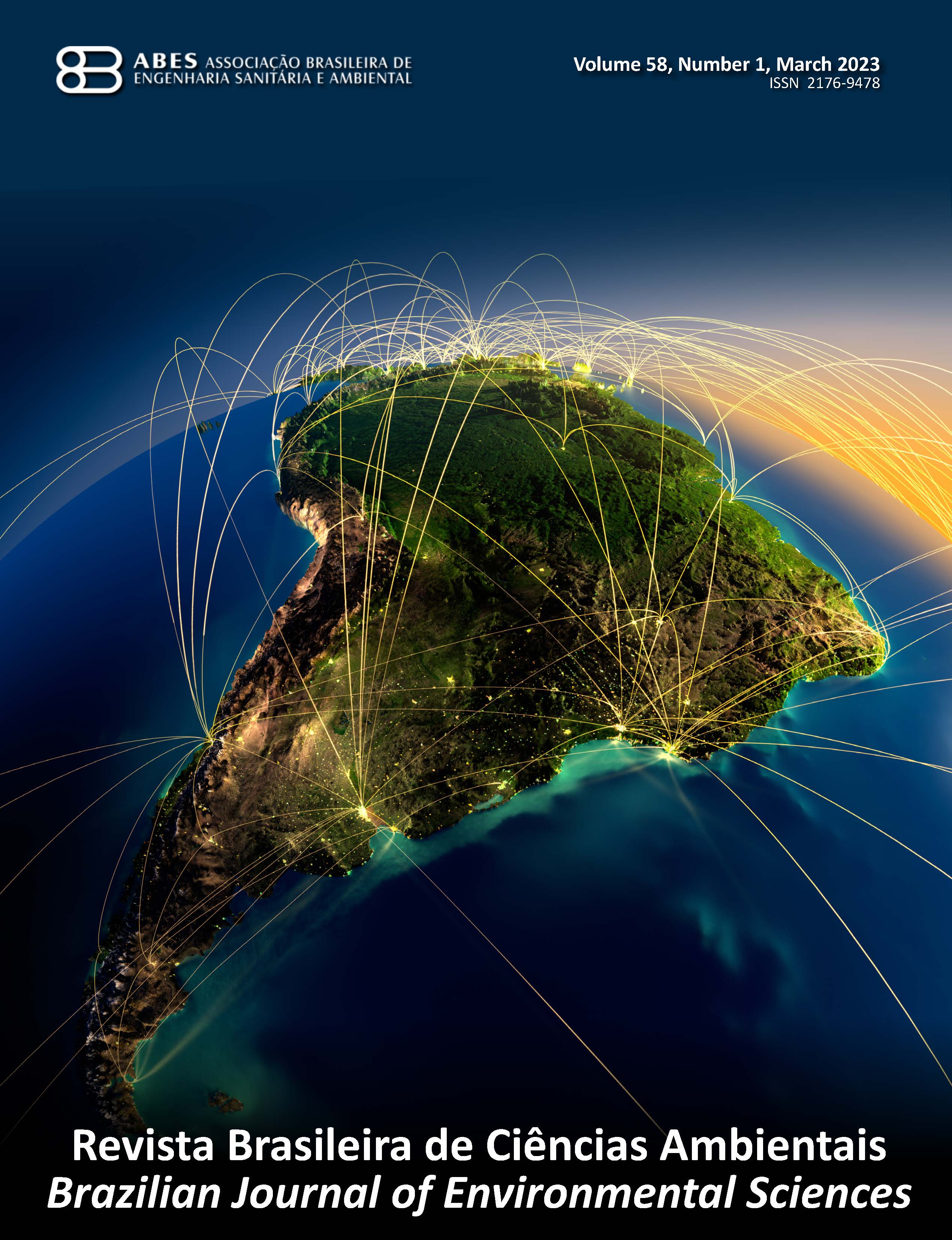Biodiversity and forestry: relative abundance of Nothura maculosa in eucalyptus plantations and native grasslands in southern Brazil
DOI:
https://doi.org/10.5327/Z2176-94781554Palavras-chave:
desertos verdes; Bioma Pampa; codorna-amarela; Florestas Plantadas.Resumo
Nas últimas décadas, o agronegócio tem apresentado grande expansão no bioma Pampa. A silvicultura, principalmente com eucalipto, expandiu seu plantio no estado do Rio Grande do Sul (RS), sul do Brasil. O objetivo deste estudo é contribuir para o entendimento do impacto das florestas plantadas na biodiversidade do Pampa brasileiro, através da comparação da abundância relativa de Nothura maculosa em áreas de campo nativo e áreas com plantios jovens (6–12 meses) de eucalipto. Cães de aponte foram utilizados para definir a abundância relativa (indivíduos por hora) de N. maculosa em 16 fazendas e dez plantações de eucalipto. O total de 307 indivíduos de N. maculosa foi registrado nas 26 propriedades amostradas, sendo 188 em pastagens (média de 12,6 ind.h-1) e 119 em plantios de eucalipto (média de 13,5 ind.h-1). Não foram encontradas diferenças estatisticamente significantes entre as áreas amostradas (p = 0,18; α = 0,05). A principal conclusão deste estudo é que quando o mosaico espaço-temporal de paisagem é considerado, o termo “deserto verde” fica bastante limitado.
Downloads
Referências
AGEFLOR, 2020. O setor de base florestal do Rio Grande do Sul 2020: ano base 2019. Associação Gaúcha de Empresas Florestais. 82 p. (Accessed January 3, 2023) at:. http://www.ageflor.com.br/noticias/wp-content/uploads/2020/12/O-Setor-de-Base-Florestal-no-Rio-Grande-do-Sul-2020-ano-base-2019.pdf.
Alves, T.R.; Fonseca, R.C.B.; Engel, V.R., 2012. Mamíferos de médio e grande porte e sua relação com o mosaico de hábitats na Cuesta Botucatu, Estado de São Paulo, Brasil. Iheringia, v. 102, (2), 150-158. https://doi.org/10.1590/S0073-47212012000200006.
Barlow, J.; Araujo, I.S.; Overal, W.L.; Gardner, T.A.; Mendes, F.S.; Lake, I.R.; Peres, C.A., 2008. Biodiversity and composition of fruit-feeding butterflies in tropical Eucalyptus plantations. Biodiversity and Conservation, v. 17, (5), 1089-1104. https://doi.org/10.1007/s10531-007-9240-0.
Bencke, G.A., 2010. Diversidade e Conservação da Fauna dos Campos do Sul do Brasil. In: Pillar, V.P.; Muller, S.C.; Castilhos, Z.M.S.; Jacques, A.V.A. (Eds.), Campos Sulinos: conservação e uso sustentável da biodiversidade. Ministério do Meio Ambiente, Brasília, pp. 101-121.
Berthrong, S.T.; Piñero, G.; Jobbágy, E.G.; Jackson, R.B., 2012. Soil C and N changes with afforestation of grasslands across gradients of precipitation and plantation age. Ecological Applications, v. 22, (1), 76-86. https://doi.org/10.1890/10-2210.1.
Bettega, R.P.; Trevisan, A.C.D., 2022. Controle da germinação de Capim-anoni (Eragrostis plana VEES): inovação com bioinsumos botânicos. Research, Society and Development, v. 11, (17), e267111739142. https://doi.org/10.33448/rsd-v11i17.39142.
Bilenca, D.; Miñarro, F., 2004. Identificación de Áreas Valiosas de Pastizal (AVPs) en las Pampas y Campos de Argentina, Uruguay y de sur de Brasil. Fundación Vida Silvestre. Argentina, Buenos Aires. 353 pp.
Bonilla-Sánchez, Y.M.; Serio-Silva, J.C.; Pozo-Montuy, G.; Chapman, C.A., 2012. Howlers are able to survive in Eucalyptus plantations where remnant and regenerating vegetation is available. International Journal of Primatology, v. 33, (1), 233-245. https://doi.org/10.1007/s10764-011-9569-9.
Brasil, 2012. Lei Federal nº 12.651/2012 (Native vegetation protection law). (Accessed December 16, 2022) at:. https://www2.camara.leg.br/legin/fed/lei/2012/lei-12651-25-maio-2012-613076-normaatualizada-pl.pdf.
Bremer, L.L.; Farley, K.A., 2010. Does plantation forestry restore biodiversity or create green deserts? A synthesis of the effects of land-use transition ns on plant species richness. Biodiversity and Conservation, v. 19, (14), 3893-3915. https://doi.org/10.1007/s10531-010-9936-4.
Brockerhoff, E.G.; Jactel, H.; Parrota, J.A.; Quine, C.P.; Sayer, J., 2008. Plantation forest and biodiversity: oxymoron or opportunity? Biodiversity and Conservation, v. 17, (5), 925-951. https://doi.org/10.1007/s10531-008-9380-x.
Bump, G.; Bump, J., 1969. A study of the spotted tinamous and the pale spotted tinamous of Argentina. US Fish and Wildlife Service Special Scientific Report – Wildlife 120, Washington, D.C. 172 pp.
Campos, B.M.; Charters, J.D.; Verdade, L.M., 2018. Diversity and distribution patterns of medium to large mammals in a silvicultural landscape in southeasten Brazil. iForest, v. 11, (6), 802-808. https://doi.org/10.3832/ifor2721-011.
Carnus, J.-M.; Parrota, J.; Brockerhoff, E.; Arbez, M.; Jactel, H.; Kremer, A.; Lamb, D.; O’Hara, K.; Walters, B., 2006. Planted Forest and Biodiversity. Journal of Forestry, v. 104, (2), 65-77. https://doi.org/10.1093/jof/104.2.65.
Carvalho, P.C.F.; Paruelo, J.; Ayala, W., 2008. La intensificación productiva en los pastizales del Río de la Plata: tendencias y consecuencias ecosistémicas. XXII Reunión del Grupo Técnico en Forrajeras del Cono Sur: Grupo Campos: 29-40.
Cordeiro, J.L.P.; Hasecack, H., 2009. Cobertura vegetal atual do Rio Grande do Sul. In: Pillar, V.P.; Muller, S.C.; Castilhos, Z.M.S.; Jacques, A.V.A. (Eds.), Campos Sulinos: conservação e uso sustentável da biodiversidade. Ministério do Meio Ambiente, Brasília, pp. 285-299.
Costella, E.; Garcia, B.A.; Costa, L.S.; Corneleo, N.S.; Schunemann, A.L.; Stefenon, V.M., 2013. Anthropogenic use of gallery in the Brazilian Pampa. Acta Scientiarum, v. 35, (2), 211-217. https://doi.org/10.4025/actascibiolsci.v35i2.13458
Cravino, A.; Brazeiro, A., 2021. Grasslands Afforestation in South America: local scale impacts of Eucalyptus plantations on uruguayan mammals. Forest Ecology and Management, v. 484, 118937. https://doi.org/10.1016/j.foreco.2021.118937.
Crego, R.D.; Macri, I.N., 2009. Una técnica para la estimación de la densidade y el monitoreo de poblaciones de inambú común (Nothura maculosa) em ambientes de pastizal. Hornero, v. 24, (1), 31-35.
Farley, K.A.; Jobbágy, E.G.; Jackson, R.B., 2005. Effects of afforestation on water yield: a global synthesis with implications for policy. Global Change Biology, v. 11, (10), 1565-1576. https://doi.org/10.1111/j.1365-2486.2005.01011.x.
Forest Stewardship Council (FSC), 2015. FSC Principles and Criteria for Forest Stewardship. FSC-STD-01-001 V5-2 EN. Forest Stewardship Council, A.C. 32 pp. (Accessed December 26, 2022) at:. https://my.fsc.org/my-en/forest-stewardship/fsc-principles-and-criteria-for-forest-stewardship.
Fundação Estadual de Proteção Ambiental (FEPAM), 2010. Zoneamento Ambiental da Silvicultura: estrutura, metodologia, resultados. (Accessed December 20, 2022) at:. https://fepam.rs.gov.br/zoneamento-ambiental-para-a-atividade-de-silvicultura-no-rs.
Hartley, M.J., 2002. Rationale and methods for conserving biodiversity in plantation forest. Forest Ecology and Management, v. 155, (1-3), 81-95. https://doi.org/10.1016/S0378-1127(01)00549-7.
Hilgert-Moreira, S.B.; Fernandes, M.Z.; Marchett, C.A.; Blochtein, B., 2014. Do different landscapes influence the response of native and non-native bee species in the Eucalyptus pollen foraging, in Southern Brazil? Forest Ecology and Management, v. 313, 152-160. https://doi.org/10.1016/j.foreco.2013.10.049.
Horák, J.; Brestovanská, T.; Mladenović, S.; Koutb, J.; Boguschc, P.; Haldac, J.P.; Zasadild, P., 2019. Green desert?: Biodiversity patterns in forest plantations. Forest Ecology and Management, v. 433, 343-348. https://doi.org/10.1016/j.foreco.2018.11.019.
Jackson, R.B.; Jobbágy, E.G.; Avissar, R.; Roy, S.B.; Barrett, D.J.; Cook, C.W.; Farley, K.A.; Maitre, D.C.; McCarl, B.A.; Murray, B.C., 2005. Trading Water for Carbon with Biological Carbon Sequestration. Science, v. 310, (5756), 1944-1947. https://doi.org/10.1126/science.1119282.
Jobbágy, E.G.; Jackson, R.B., 2004. Groundwater use and salinization with grassland afforestation. Global Change Biology, v. 10, (8), 1299-1312. https://doi.org/10.1111/j.1365-2486.2004.00806.x.
Kliger, M.; Ginzburg, R.G., 2022. Effectiveness of the obligation of keeping forest strips for native forest connectivity and conservation in the dry Chaco, Argentina. Forest Systems, v. 31, (3), e017. https://doi.org/10.5424/fs/2022313-18906.
Kneeshaw, D.; Leduc, A.; Drapeau, P.; Gauthier, S.; Paré, D.; Carignan, R.; Doucet, R.; Bouthillier, L.; Messier, C., 2000. Development of integrated ecological standards of sustainable forest management at an operational scale. Forest Chronicle, v. 76, (3), 481-493. https://doi.org/10.5558/tfc76481-3.
Leidinger, J.L.G.; Gossner, M.M.; Weisser, W.W.; Koch, C.; Cayllahua, Z.L.R.; Podgaiski, L.R.; Duarte, M.M.; Araujo, A.S.F.; Overbeck, G.E.; Hermann, J-M.; Kollmann, J.; Meyer, S.T., 2017. Historical and recent land use affects ecosystem functions in subtropical grasslands in Brazil. Ecosphere, v. 8, (12), e02032. https://doi.org/10.1002/ecs2.2032.
Lindenmayer, D.B.; Hobbs, R.J., 2004. Fauna conservation in Australian plantations forests – a review. Biology and Conservation, v. 119, (2), 159-168. https://doi.org/10.1016/j.biocon.2003.10.028.
Lindenmayer, D.B.; Wood, J.T.; Cunningham, R.B.; Crane, M.; Macgregor, C.; Michael, D.; Montague-Drake, R., 2009. Experimental evidence of the effects of a changed matrix on conserving biodiversity within patches of native forest in an industrial plantation landscape. Landscape Ecology, v. 24, (8), 1091-1103. https://doi.org/10.1007/s10980-008-9244-5.
Mazzolli, M., 2010. Mosaics of exotic forest plantation and native forest as habitat of Pumas. Environmental Management, v. 46, (2), 237-253. https://doi.org/10.1007/s00267-010-9528-9.
Menegheti, J.O., 1985. Densidade de Nothura maculosa Temminck 1815 (Aves, Tinamidae): variação anual. Iheringia, v. 1, 87-100.
Menegheti, J.O.; Silva, F.; Vieira, M.I.; Bretschneider, D.; Marques, M.I.B., 1981. Spatial and temporal variations of Nothura maculosa (Temminck, 1815) from hunting data 1977, in Rio Grande do Sul state, Brazil. Iheringia, v. 58, 23-30.
Pinheiro, R.T.; Lopez, G., 1999. Abundancia del tinamú manchado (Nothura maculosa) y del tinamú alirrojo (Rhynchotus rufescens) en una área cinegética del Rio Grande do Sul (Brasil). Ornitología Neotropical, v. 10, 35-41.
Pinto, L.C.; Duarte, M.M., 2013. Occurrence (new record) of maned wolf Chrysocyon brachyurus (Illiger, 1815) (Carnivora, Canidae) in southern Brazil. Ciência Florestal, v. 23, (1), 253-259. https://doi.org/10.5902/198050988459.
Pozo, P.; Säumel, I., 2018. How to Bloom the Green Desert: Eucalyptus Plantations and Native Forests in Uruguay beyond Black and White Perspectives. Forest, v. 9, (10), 614. https://doi.org/10.3390/f9100614.
Roesch, L.F.W.; Vieira, F.C.B.; Pereira, V.A.; Schunemann, A.L.; Teixeira, I.F.; Senna, A.J.T., Stefenon, V.M., 2009. The Brazilian Pampa: a Fragile Biome. Diversity, v. 1, (2), 182-198. https://doi.org/10.3390/d1020182.
Sapucci, G.R.; Negri, R.G.; Massi, K.G.; Alcântara, E.H., 2022. Eucalyptus plantation benefits to patch size and shape of forested areas in southeast atlantic forest. Revista Árvore, v. 46, e4626. https://doi.org/10.1590/1806-908820220000026.
Silveira, L.; Jácomo, A.T.A.; Rodrigues, F.H.G.; Crawshaw, P.G., 1997. Hunting association between the aplomado falcon (Falco femoralis) and the maned wolf (Chrysocyon brachyurus) in Emas National Park, Central Brazil. The Condor, v. 99, (1), 201-202. https://doi.org/10.2307/1370238.
Thompson, J.J.; Carroll, J.P., 2006. Habitat use and survival of the spotted tinamou (Nothura maculosa) in agroecosystems in the province of Buenos Aires, Argentina. In: Cederbaum, S.B.; Faircloth, B.C.; Terhune, T.M.; Thompson, J.J.; Carroll, J.P. (eds). Gamebird 2006: Quail IV and Perdix XII. Warnell School of Forestry and Natural Resources. Athens, GA, USA. 111-119 pp.
Timo, T.P.C.; Lyra-Jorge, M.C.; Gheler-Costa, C.; Verdade, L.M., 2015. Effect of the plantation age on the use of Eucalyptus stands by medium to large-sized wild mammals in south-eastern Brazil. iForest, v. 8, (2), 108-113. https://doi.org/10.3832/ifor1237-008.
Viani, R.A.G.; Durigan, G.; Melo, A.C.G., 2010. A regeneração natural sob plantações florestais: desertos verdes ou redutos de biodiversidade? Ciência Florestal, v. 20, (3), 533-552. https://doi.org/10.5902/198050982067.
Downloads
Publicado
Como Citar
Edição
Seção
Licença
Copyright (c) 2023 Revista Brasileira de Ciências Ambientais

Este trabalho está licenciado sob uma licença Creative Commons Attribution 4.0 International License.

























